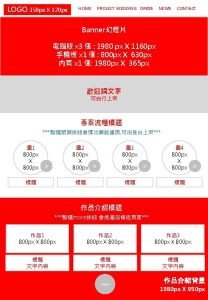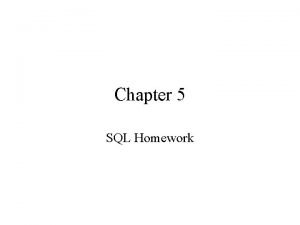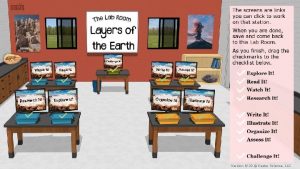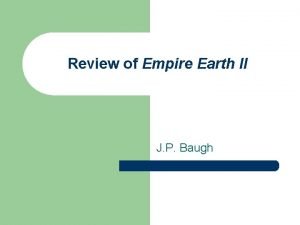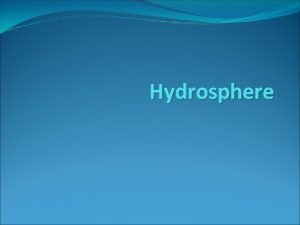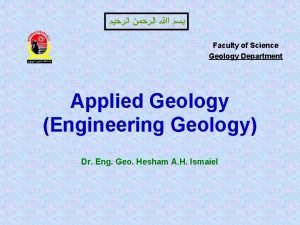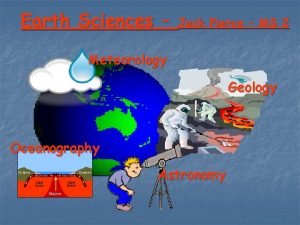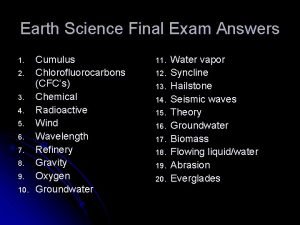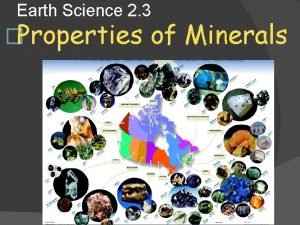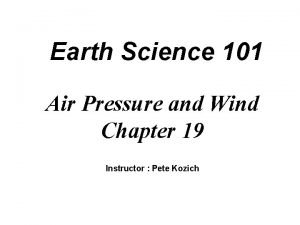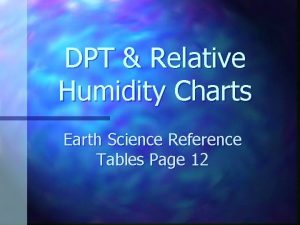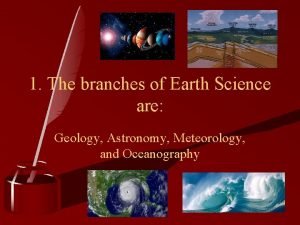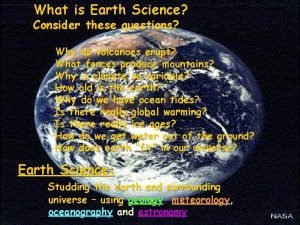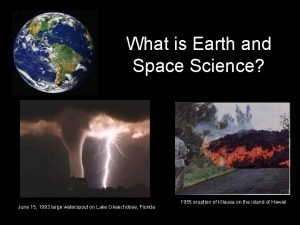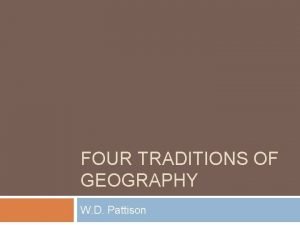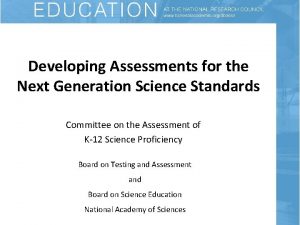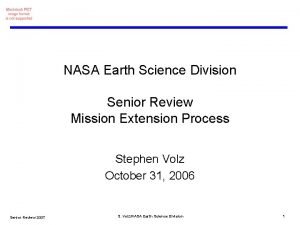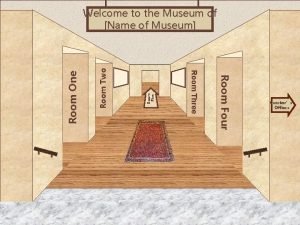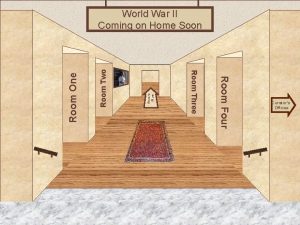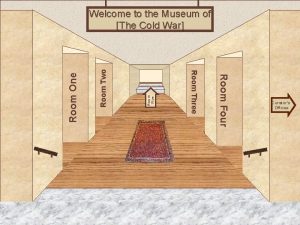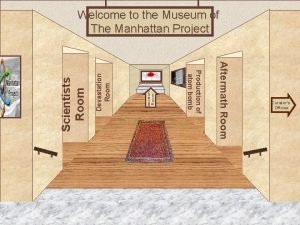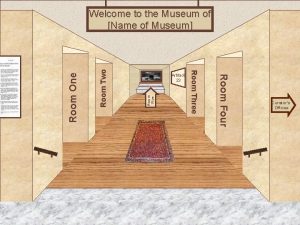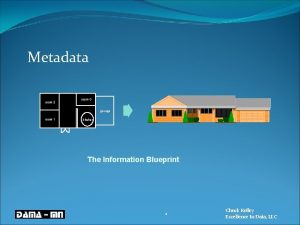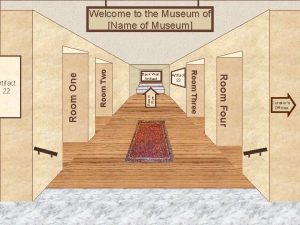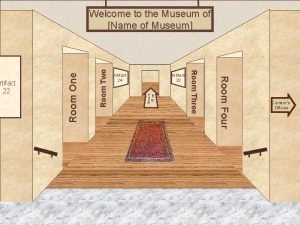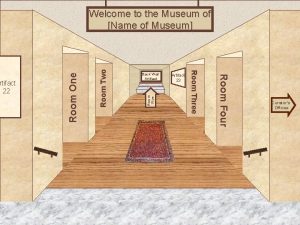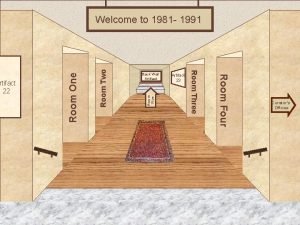Earth Science Prologue Review Miss Wojdan Room 120










































- Slides: 42

Earth Science: Prologue Review Miss Wojdan Room 120

Prologue Review 1. Using your knowledge of metric conversions, convert 112. 5 cm into m. 112. 5 cm 1. 125 m

Prologue Review 2. Write the number 2, 055, 010. 0 in scientific notation. 2. 05501 x 10 ⁶

Prologue Review 3. The amount of matter (atoms) in an object is called: MASS

Prologue Review 4. A number of objects are grouped on the basis of common properties. What is this called? A. Classification B. Observation C. Inference D. Measurement

Prologue Review 4. A number of objects are grouped on the basis of common properties. What is this called? A. Classification B. Observation C. Inference D. Measurement

Prologue Review 5. What is the density of a rock which has a mass of 35. 0 grams and a volume of 7. 0 cubic centimeters? Density = Mass Volume Density = 35. 0 g 7. 0 cmᵌ Density = 5. 0 g/cmᵌ

Prologue Review 6. A student measured the mass of a rock sample and recorded it as 51 grams. Later it is found that the accepted value of the rock's mass is 60 grams. What is the Percent Error? Percent Error = Accepted – Measured x 100 Accepted Percent Error = 60. 0 g – 51. 0 g x 100 60. 0 g Percent Error = 15%

Prologue Review 7. As water cools from 4⁰C to 0⁰C, what happens to its density? A. Increases B. Decreases C. Stays the same D. Fluctuates

Prologue Review 7. As water cools from 4⁰C to 0⁰C, what happens to its density? A. Increases B. Decreases C. Stays the same D. Fluctuates

Prologue Review 8. While on a field trip to a large lake in New York State, an observer recorded four statements about this lake. Which of these statements is most likely an inference? A. There is a log floating in the water B. The water temperature is 18. 0⁰C C. The water is clear enough to see the bottom D. The lake was formed by glaciers

Prologue Review 8. While on a field trip to a large lake in New York State, an observer recorded four statements about this lake. Which of these statements is most likely an inference? A. There is a log floating in the water B. The water temperature is 18. 0⁰C C. The water is clear enough to see the bottom D. The lake was formed by glaciers

Prologue Review 9. In which phase (state) do most Earth materials have their greatest density? A. Solid B. Liquid C. Gaseous

Prologue Review 9. In which phase (state) do most Earth materials have their greatest density? A. Solid B. Liquid C. Gaseous

Prologue Review 10. If a wooden block were cut into eight identical pieces, the density of each piece compared to the density of the original block would be: A. Less B. Greater C. The same

Prologue Review 10. If a wooden block were cut into eight identical pieces, the density of each piece compared to the density of the original block would be: A. Less B. Greater C. The same

Prologue Review 11. Compared to the density of liquid water, the density of an ice cube is: A. Always less B. Always the same C. Always greater D. Sometime greater, sometimes less

Prologue Review 11. Compared to the density of liquid water, the density of an ice cube is: A. Always less B. Always the same C. Always greater D. Sometime greater, sometimes less

Prologue Review 12. A rectangular box has a mass of 75. 0 g. If the length of the sides are 3. 0 cm, 4. 2 cm, and 70. 0 mm, what is the density of the box? 70. 0 mm 7. 0 cm Volume = L x W x H = (3. 0 cm) x (4. 2 cm) x (7. 0 cm) Volume = 88. 2 cmᵌ Density = Mass = 75. 0 g = 0. 9 g/cmᵌ Volume 88. 2 cmᵌ

Prologue Review 13. What is the average density of the three samples of gypsum?

Prologue Review 14. What is the most important reason that scientists display data in graphs? A. Graphs never contain errors B. Graphs take up less space than data tables C. Graphs make data easier to understand D. Graphs make papers more likely to get published

Prologue Review 14. What is the most important reason that scientists display data in graphs? A. Graphs never contain errors B. Graphs take up less space than data tables C. Graphs make data easier to understand D. Graphs make papers more likely to get published

Prologue Review 15. Pumice is an unusual rock, because it can float in water. What does this tell you about pumice? A. Pumice is usually found in very small pieces B. Pumice is most common at high altitudes C. Pumice absorbs water very well D. Pumice is less dense than water

Prologue Review 15. Pumice is an unusual rock, because it can float in water. What does this tell you about pumice? A. Pumice is usually found in very small pieces B. Pumice is most common at high altitudes C. Pumice absorbs water very well D. Pumice is less dense than water

Prologue Review 16. A large rectangular object has three sides equaling 4. 0 cm, 5. 5 cm, and 8. 0 cm. Its density is 550 g/cm³. What is this object’s mass?

Prologue Review 16. A large rectangular object has three sides equaling 4. 0 cm, 5. 5 cm, and 8. 0 cm. Its density is 550 g/cm³. What is this object’s mass? Volume = (4. 0 cm) x (5. 5 cm) x (8. 0 cm) Volume = 176 cm³ Mass = Volume x Density Mass = (176 cm³) x (550 g/cm³) Mass = 96, 800 g

Prologue Review 17. A student incorrectly measured the volume of a mineral sample as 64 cubic centimeters. The actual volume was 70 cubic centimeters. What was the student’s approximate percent deviation (percentage of error)? A. 6. 0 % B. 8. 6% C. 9. 4% D. 10. 6%

Prologue Review 17. A student incorrectly measured the volume of a mineral sample as 64 cubic centimeters. The actual volume was 70 cubic centimeters. What was the student’s approximate percent deviation (percentage of error)? A. 6. 0 % B. 8. 6% C. 9. 4% D. 10. 6%

Prologue Review 18. An Earth Science class went on a field trip to the Adirondacks and conducted several experiments. Based on their notes listed below, which one is an inference, not an observation? A. This rock appears to have banding B. On September 15 th, the temperature of Lake George was 56⁰F C. The rock is glassy, because it cooled quickly D. The fossil contains seashell fragments

Prologue Review 18. An Earth Science class went on a field trip to the Adirondacks and conducted several experiments. Based on their notes listed below, which one is an inference, not an observation? A. This rock appears to have banding B. On September 15 th, the temperature of Lake George was 56⁰F C. The rock is glassy, because it cooled quickly D. The fossil contains seashell fragments

Prologue Review 19. As ‘Variable X’ increases, ‘Variable Y’ decreases. This statement represents which kind of graphical relationship? A. Direct Relationship B. Indirect Relationship C. Cyclic Relationship D. No Relationship

Prologue Review 19. As ‘Variable X’ increases, ‘Variable Y’ decreases. This statement represents which kind of graphical relationship? A. Direct Relationship B. Indirect Relationship C. Cyclic Relationship D. No Relationship

Prologue Review 20. The boundary between two opposing forces is known as A. Inference B. Equilibrium C. Interface D. Cyclic Relationship

Prologue Review 20. The boundary between two opposing forces is known as A. Inference B. Equilibrium C. Interface D. Cyclic Relationship

Prologue Review 21. Express the number 2/1, 000 in scientific notation.

Prologue Review 21. Express the number 2/100 in scientific notation. 2 / 1, 000 = 0. 002 2. 0 x 10⁻³

Prologue Review 22. Using the graph below, state the relationship between the x- and y-variable.

Prologue Review 22. Using the graph below, state the relationship between the x- and y-variable. As age (months) increases, height (cm) increases

Prologue Review 23. The diagrams represent particles of the same type of sedimentary rock material collected from a streambed. The diagrams are drawn to scale. Particle A has a density of 2. 7 grams per cubic centimeter and a volume of 15. 0 cubic centimeters. What is the mass of this particle? A. 5. 5 g B. 15. 0 g C. 40. 5 g D. 109. 3 g

Prologue Review 23. The diagrams represent particles of the same type of sedimentary rock material collected from a streambed. The diagrams are drawn to scale. Particle A has a density of 2. 7 grams per cubic centimeter and a volume of 15. 0 cubic centimeters. What is the mass of this particle? A. 5. 5 g B. 15. 0 g C. 40. 5 g D. 109. 3 g

Prologue Review 24. The diagram below represents a graduated cylinder filled with liquid. What is the volume of the liquid? A. 43 m. L B. 43 cm³ C. 47 m. L D. 47 cm³

Prologue Review 24. The diagram below represents a graduated cylinder filled with liquid. What is the volume of the liquid? A. 43 m. L B. 43 cm³ C. 47 m. L D. 47 cm³
 Earth science prologue review
Earth science prologue review Let's look at some examples
Let's look at some examples 120px x 120px
120px x 120px 100+80+60+40+20
100+80+60+40+20 Earth science lab practical review
Earth science lab practical review Dinoflagellates
Dinoflagellates Earth science sol review
Earth science sol review Earth science review book
Earth science review book Earth science final exam review
Earth science final exam review The canterbury tales prologue review
The canterbury tales prologue review What s your favorite subject
What s your favorite subject Bedroom bathroom living room kitchen
Bedroom bathroom living room kitchen Room nineteen summary
Room nineteen summary Hotel.hotelno=room.hotelno(hotel room)
Hotel.hotelno=room.hotelno(hotel room) Kesler science crossword answer key
Kesler science crossword answer key Empire earth 2 review
Empire earth 2 review Meteorological symbols for four types of fronts
Meteorological symbols for four types of fronts Earth science sol 2010
Earth science sol 2010 Earth science lab practical
Earth science lab practical Earth science regents lab practical
Earth science regents lab practical Earth science grade 9
Earth science grade 9 Dynamic equilibrium earth science
Dynamic equilibrium earth science Hydrosphere
Hydrosphere Fcat science 8th grade
Fcat science 8th grade Geology earth science definition
Geology earth science definition Earth science meaning
Earth science meaning Geology earth science definition
Geology earth science definition Earth science vs geology
Earth science vs geology Earth science lab practical
Earth science lab practical Earth science final exam answers
Earth science final exam answers Properties of mineral
Properties of mineral Vertical structure of the earth
Vertical structure of the earth Relative humidity reference table
Relative humidity reference table 4 branches of earth science
4 branches of earth science 282 ways to pass the earth science regents
282 ways to pass the earth science regents Earth science branches
Earth science branches Honors earth science
Honors earth science Why study earth science
Why study earth science Earthology definition
Earthology definition Wd pattison
Wd pattison Plate earth science
Plate earth science The sun warms the earth unevenly science or pseudoscience
The sun warms the earth unevenly science or pseudoscience Nasa divisions
Nasa divisions


